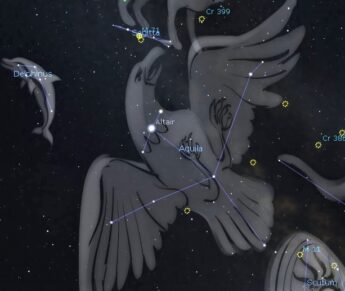This Week’s Sky at a Glance, 2023 July 29 – August 5
This Week’s Sky at a Glance, 2023 July 29 – August 5
After twilight the bright star Altair is halfway up in the southeastern sky, forming the lower peak of the Summer Triangle with Vega and Deneb. It is flanked by two somewhat dimmer stars, Tarazed and Alshain, and the trio forms the head of Aquila the Eagle. The eagle’s body and tail stretch southward, while the wings reach forward to propel it up the Milky Way. In Greek mythology the eagle was the pet of Zeus and the bearer of his deadly thunderbolts. In Chinese mythology Tchi-Niu (Lyra) was a princess and royal weaver, and Kien-Niou (Aquila) tended the king’s cows. The two fell in love and were married but they subsequently neglected their chores. Angered, the king placed the herder on the opposite side of the river, represented by the Milky Way. On the seventh day of the seventh month all of the magpies in the country form a bridge to allow the lovers to be together for one day.
Following a string of stars beyond the eagle’s tail, over the constellation border into Scutum the Shield, a binocular search will pick up a smudge of light which is a cluster of stars called M11 or the Wild Duck Cluster. From the eagle’s head toward Cygnus or Lyra is a tiny constellation called Sagitta the Arrow. Look to the upper right of the arrow’s fletching with binoculars to see a popular asterism of about a dozen stars. Although it is upside down you will recognize the Coathanger Cluster, also known as Collinder 399 or Brocchi’s Cluster.
This Week in the Solar System
Saturday’s sunrise in Moncton is at 5:57 am and sunset will occur at 8:53 pm, giving 14 hours, 56 minutes of daylight (6:05 am and 8:55 pm in Saint John). Next Saturday the Sun will rise at 6:05 am and set at 8:43 pm, giving 14 hours, 38 minutes of daylight (6:13 am and 8:46 pm in Saint John).
The Moon is full and near perigee on Tuesday, resulting in more extreme tidal ranges mid-week, and it passes below Saturn on Thursday morning. This weekend Venus sets less than half an hour after sunset, followed by Mercury half an hour later and Mars a half-hour after that. Binoculars are needed to see them. Just before Mars sets Saturn will be rising in Aquarius to the east-southeast, giving good telescopic views of its rings around midnight. Jupiter rises shortly after 12:30 am to lord over the night sky. The minor South Delta Aquariid meteor shower peaks this weekend with shooting stars seemingly emanating from Saturn.
The Saint John Astronomy Club meets at the Rockwood Park Interpretation Centre at 7 pm on August 5.
Weekly Sky at a Glance ~by Curt Nason

